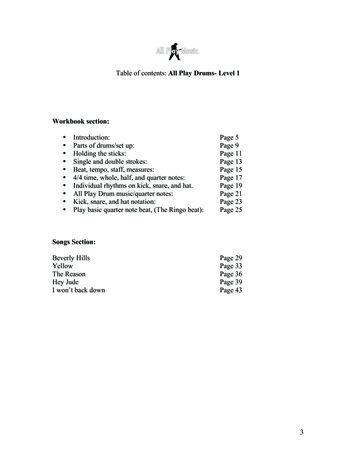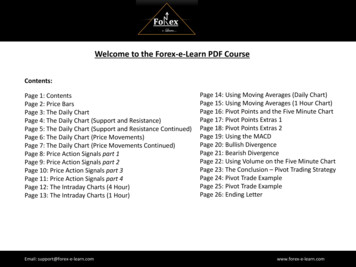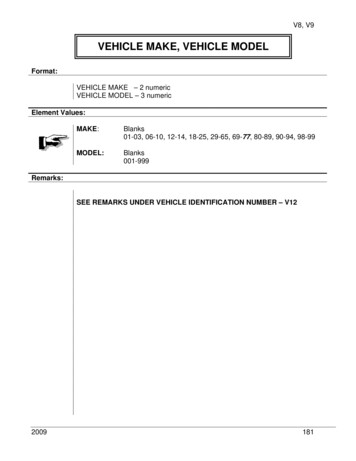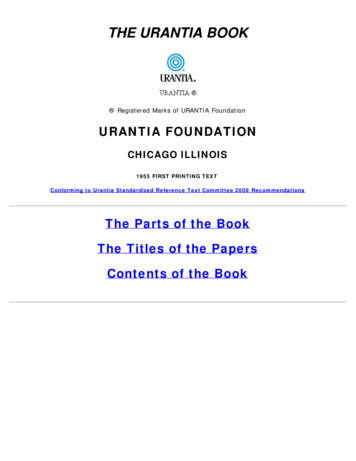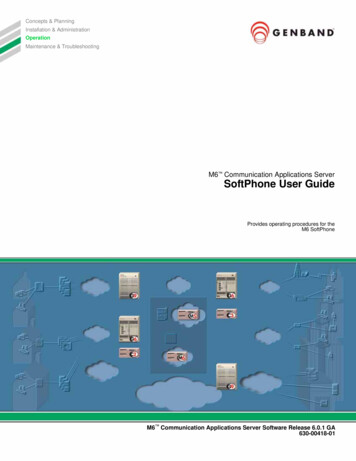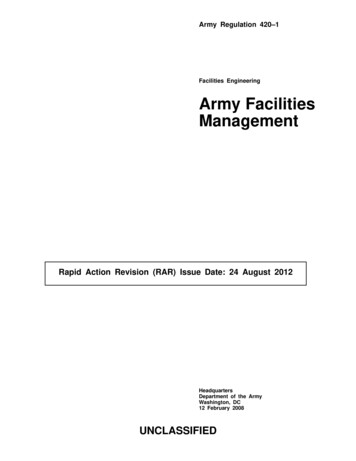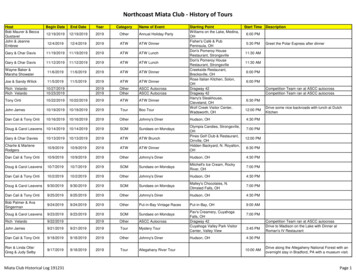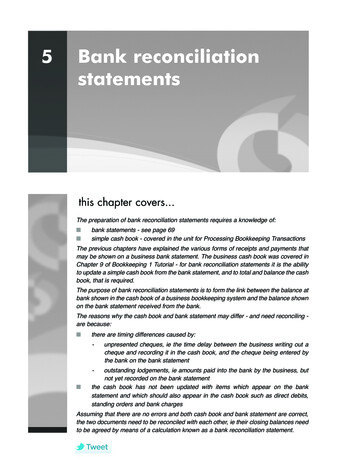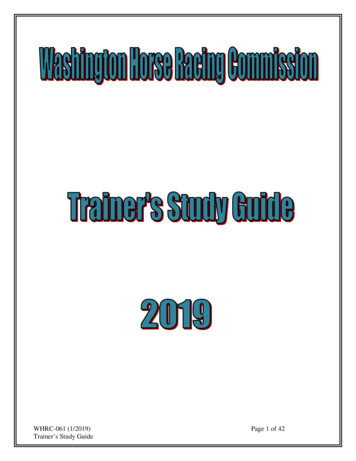
Transcription
WHRC-061 (1/2019)Trainer’s Study GuidePage 1 of 42
Table of ContentsLicensingMultiple LicensesAuthority to SearchCriminal HistoryTemporary Owners LicenseStable Names555556Labor & Industries Industrial Insurance RequirementsTrainer L&I FeesDuties of Each Job by Job ClassificationMinor Work PermitsOn the Job InjuriesOut of StatePartnership Disputes667888Racing OfficialsSteward, Racing SecretaryHorsemen's Bookkeeper, Official VeterinarianHorse Identifier, Paddock Judge, StarterClerk of Scales, Clocker, Paddock Plater, Outrider99101112Trainer's ResponsibilityFinancial ResponsibilityRace Day EquipmentRegistration PapersSaddling for RaceSafety EquipmentRules While on HorsebackCell Phone Usage1213131414151516ClaimingClaiming ProceduresClaimed Horse Goes to Test BarnSale or Transfer of Claimed HorseVoided Claim1617171818Entries, Scratches, StartsEntry Dates, Eligibility, Weight AllowanceRegistration Papers, Jockey Named to RideNon-recognized Race MeetsMultiple Entries1818202020WHRC-061 (1/2019)Trainer’s Study GuidePage 2 of 42
Preference in RaceOvernights, Also Eligible, In TodayScratches/Enter to run, Horses on Ground202021Jockeys, Weights & EquipmentJockey's WeightWeighing Out, Weighing InQuick OfficialApprentice Jockey2222222223Post to FinishPost Parade, Head Numbers/Jockey Arm BandsStarting Gate, Inquiry/Objections232323Equipment & TackHorseshoes, Bits, Racing BridleBlinkers, Shadow Roll, Figure Eight, Cheek PiecesBreast Plate, Martingale, Wraps24242525Racing Terms Glossary26Drug & Alcohol Violations30Veterinary Policy & ProceduresPenaltiesMedication LabelingEquine Inspections, Veterinarian ListEquine Testing, Sample Collection/Split SamplesProhibited SubstancesPermitted Medication, FurosemideBleeder ListBicarbonate TestingPosterior Digital NeurectomyBred or Pregnant MaresExtracorporeal Shock Wave TherapyVeterinary & Horse Health GlossaryDiagram - Parts of the HorseDiagram - Equine Lower Leg & Hoof & Distal Forelimb StructureDiagram - Unsoundness in the Horse31313232333334353535363636404142WHRC-061 (1/2019)Trainer’s Study GuidePage 3 of 42
Washington Horse Racing CommissionTrainer Study GuideThe following information is designed to assist applicants who are applying for a trainer or assistanttrainer license for the first time. When applying for their initial license the applicant will be requiredto pass a written, an oral and practical test to assure that he/she is qualified to be a trainer/assistanttrainer. As a licensed trainer/assistant trainer you are expected to understand and follow all the rules ofracing. All questions on the written test will be covered in this study guide, the Trainers Manual(includes Veterinary Policy and Procedures), racing association condition book and the rules of racing(Title 260 WAC). If you are able to use the Internet you can access the rules of racing by goingwww.whrc.wa.gov and go to the “rules of racing” tab.This study guide is intended to highlight some of the rules and policies that you will need to have agood understanding of prior to becoming a trainer. You will also need to study all the rules of racing.The following chapters pertain to the day-to-day activities of the trainers:Chapter 260-24 – Association officials and employeesChapter 260-28 - Ownerships, trainers and employeesChapter 260-32 – Jockeys, Apprentices and agentsChapter 260-34 - Drug and Alcohol testing of licenseesChapter 260-36 - LicensesChapter 260-40 - Entries, starts, declarations and scratchesChapter 260-44 - Weights and equipmentChapter 260-52 - The race –Paddock to finishChapter 260-56 – Objections and protestsChapter 260-60 - ClaimingChapter 260-70 - Equine Medication programChapter 260-80 - Prohibited practicesChapter 260-84 - PenaltiesWHRC-061 (1/2019)Trainer’s Study GuidePage 4 of 42
Licensing:WAC 260-36-010 states that any one participating directly in horse racing must be licensed. A WHRClicense is issued for the calendar year and expires on December 31st. This means that when you hirean employee, before they can begin working they must have a valid WHRC license. It is theresponsibility of the trainer to insure that every person in the trainer’s employ is properly licensed bythe WHRC before being allowed to work. If the person you are hiring states that he/she is licensedyou need to actually see the license. Do not just hire someone walking down the shed row withoutchecking out his/her licensing status. This could end up being very costly to you.In addition, if there are any changes of employees, the trainer must notify the WHRC office withinforty-eight hours. (WAC 260-36-250(1)) Failure to report these changes may result in a penalty). Thisrule is intended to provide a record of the actual dates a person works for each trainer, which assistswhen computing the L & I premiums and when there is an L&I claim. If possible, when a trainerreleases an employee, the trainer should retrieve the employee’s license and return it to the commissionoffice. When a groom is no longer working for you, the WHRC will cancel their license for nonparticipation, however, if that person resumes working for another trainer his/her license can bereinstated. Emerald Downs’ security can issue a pass to your former employee to allow him/her anopportunity to look for work.Multiple Licenses: If as a trainer, you are performing the duties of another type of license(exercise rider, pony rider, owner, and vendor) other than a trainer you are required to be licensed foreach position. A trainer’s license does not qualify you to perform the duties of these otherlicenses. If you are getting a specific type of license for the first time you will need to meet the initiallicensing requirements.Authority to search: (WAC 260-36-180) In order to protect the integrity of horse racing and toprotect the interests and safety of the public and participants, the commission and its employees shallhave the right to enter into or upon the buildings, stables, rooms, motor vehicles or other places withinthe grounds of a racing association to examine the same and to inspect and examine the personalproperty and effects of any licensee within such places. Any person who has been granted a license bythe commission, by accepting a license, authorizes the commission or its employees to search his/herperson and the areas indicated herein and to seize any medication, drugs, paraphernalia or deviceprohibited by the rules of racing, or other evidence of a violation of the rules of racing. If a licenseerefuses to allow a search, the board of stewards will revoke his/her license.Criminal History: WAC 260-36-120 lists several reasons and situations that could result in alicense being denied, suspended or revoked. This WAC states the various types of criminal historythat would result in the employee not being able to be licensed in the racing industry. All newapplicants must be fingerprinted and returning licensees will be fingerprinted every five years. It isvery important that applicants list all criminal information and/or convictions and racingviolations on his/her applications because this information will show up on the fingerprint reportsand the racing national data base and failure to list this information will result in disciplinary action.Temporary owner’s license: As a trainer, there may be a situation when you have entered ahorse to race and the owner is unable to get their license application to the WHRC. We do have aprovision where the trainer may submit an application for an owner's license on behalf of an ownerWHRC-061 (1/2019)Trainer’s Study GuidePage 5 of 42
provided all license fees and required labor and industries premiums are submitted with the applicationby the trainer (WAC 260-36-200). If you are doing this, you must provide the WHRC enoughinformation on the owner so that a license application and fingerprint card can be sent to the owner.The owner has fourteen days from the date of the trainer's submission of a license application tocomplete the license application process. If the owner fails to complete the application processwithin the fourteen days, a stewards’ ruling conference will be scheduled and a fine will be assessedand the owners’ license may be revoked or suspended. In addition, the horse will be put on thestewards’ list which makes the horse ineligible to be entered or race. When an owner’s license isrevoked or suspended, the owner will not be able to race in any jurisdiction that is reciprocal to ourrules which is most of the states and Canada.Stable Name: As a trainer you may race under a stable name as owner or part owner, however, youmust use your legal name for your trainer’s license. If more than three individuals own a horse it mustrace under a stable name. When a trainer or owner is racing under a stable name and there are anychanges in the stable or the stable is dissolved, the commission must be notified immediately. Refer toWAC 260-28-020 for the rules governing stable names.Labor & Industries Industrial Insurance Requirements:Industrial insurance for WHRC licensed assistant trainers, pony riders, exercise riders and grooms atEmerald Downs and the Class C meets during the live racing, is provided through the Department ofLabor and Industries (L&I) Horse Industry Account. However, to be covered under the Horse IndustryAccount the trainer and employee (assistant trainer, pony riders, exercise rider and groom) must have avalid WHRC license.Employees of the trainer (assistant trainers, exercise riders, pony riders, grooms) must have a validWHRC license for each duty they perform to be covered by the horse industry industrial insuranceprogram. Failure to have the proper license may result in the claim being denied under this program. Ifthe trainer does not have an individual industrial insurance account and an employee is injured, thetrainer may be fined by L & I and be responsible for the injury claim. (WAC 260-28-235)Trainer L & I fees: In order to be licensed as a trainer by the WHRC, the applicant must pay theL& I licensing premiums based on their specific stable requirements. In 2013 the method of calculatingthe premiums was changed. The method of calculation is located in the “Trainers and OwnersManual. Please refer to that booklet. Trainers are responsible to report when grooms are hired orreleased within forty-eight hours. Failure to report the dates in the time frame would result in a trainerbeing charged the industrial insurance premium for the entire month. Grooms can be hired by themonth or if only needed occasionally, they can be hired on a daily basis such as whena trainer needs extra help paddocking a horse. The trainer will be charged the dailyrate for a temporary groom, this includes having another licensed trainer help in thepaddock. A trainer who does not employ a full time groom will be charged the dailyrate when he/she has a horse running in a race. The only time a trainer (who does nothave a permanent groom) is not charged for a temporary groom is when the owner ofthat horse is helping in the paddock. Failure to keep the commission office notified ofWHRC-061 (1/2019)Trainer’s Study GuidePage 6 of 42
the names of your employees could result in disciplinary action or the trainer beingheld responsible for any expenses relating to an injury to the groom.At the end of each month the WHRC will generate an invoice for each trainer. The invoice will containthe number of stalls occupied by the trainers horses during the month at the track, the number ofgrooms employed, and if applicable, the number of exercise or pony riders employed at the farm or outof state and days worked. The trainer will have fifteen days to submit payment for the Labor andIndustries premiums. Failure to make the payment will result in a fine and could result in a suspensionof their license.Duties of each employee job classifications: Each employee must be licensed for the jobwhich they will be performing. If they are performing the duties for more than one job, they must havea license for each position. It is the trainer’s responsibility to make sure all of his/her employees areproperly licensed. If you have an exercise rider or pony rider that is going to do groom duties, theymust obtain a grooms license. As a trainer, if you permit your employees to perform job duties outsideof what is allowed for their specific license you will be subject to disciplinary action and possiblefines. The following are the job duties for each specific job:Groom – In order to perform the duties of a groom the person must have a valid WHRC groom’s license.Trainers must report to the commission all changes (hiring or lay-offs) with their employees within48 hours. Failure to keep the commission updated on your employees will result in premiums beingcharged for the groom until the commission is notified and possible fines assessed. The following are thetasks that a groom may perform: Bathe, groom, feed and water, horses. Mucks the stalls, rake and clean barn area. Clean tack and equipment. Walk horses or handle to and from walkers. Cool horse out after exercise and race. Apply medications and wraps to legs. Tack horses for training and racing. Paddock horses and handle horse in test barn.Exercise Rider – Trainers hire exercise riders to exercise, work and gate school their horsesduring training hours. Many exercise riders work for several trainers each day, therefore, thetrainers do not have to notify the commission when they change to another exercise rider. Thefollowing are the tasks that an exercise rider may perform: Exercise, gate school and “work” horses during training hours. Clean the tack Assist in unsaddling the horse upon return to barn. Communicate with trainer regarding the horse’s fitness and soundness.Pony Rider – The trainer hires a pony rider either during the morning training hours to assistwith their horses and/or during the races to lead the horse in the post parade. The following isthe only tasks a pony rider may perform: Pony horses to track for exercise during training hours. Lead horses in the post parade and to the starting gate for a race. Bathe, groom, feed and water his/her own pony horse/horses. Muck his/her own pony horse's stall and clean barn area.WHRC-061 (1/2019)Trainer’s Study GuidePage 7 of 42
Minor Work Permits: If you employ anyone under the age of 18, you are required by L & I tohave a minor work permit. This includes your own children or other relatives. A minor work permitendorsement can be obtained from L & I along with your master business license. There are specificrequirements when hiring a minor in regard to the type of work they can perform and the hours ofwork. There is a L & I publication, “Teens at Work” that explains the requirements.On the job injuries: When an employee reports an on the job injury the trainer must fill out the L& I Horsemen’s Accident report and return the form to the WHRC office immediately. The trainershould also notify the Washington Horseman’s Benevolent and Protective Association (HBPA).Injuries requiring medical attention need to be seen by the medic on duty if they are available or theHBPA can assist in the employee getting medical assistance. It is important that each trainer keepsaccurate employee records to assist with the L & I claims. These claims have a direct impact on therates charged by L & I for a trainer’s license and their employee’s licenses.Out of state: Trainers who purchase industrial insurance coverage and intend to extend the coverageto employees out-of-state must comply with the following conditions:1. Employees must have been hired in the state of Washington and be the exclusive employee ofthe trainer. This means that the employee may only work for that trainer and if any work isperformed by the employee, (either on or off the track for another employer), the employee isno longer considered an exclusive Washington employee and the coverage is no longer valid.2. If a trainer purchases industrial insurance coverage in Washington and wishes to cover theiremployees out of state they will be required to report at the beginning of each month theiremployees and will be charged the farm rate.Washington L & I has reciprocity agreements with eight states (Idaho, Oregon, Nevada, North Dakota,Montana, South Dakota, Utah, and Wyoming). Trainers who have industrial insurance with thesestates are not required to buy L & I in Washington as long as all employees are hired in the jurisdictionof coverage. No employee may be hired by the trainer in Washington, this includes, exerciseriders, pony persons, assistant trainers, grooms. This also includes using licensed jockeys formorning workouts because they are covered by L & I when performing exercise rider duties andmust have an exercise rider license. (WAC 260-36-240)Partnership Disputes:WAC 260-28-035 Partnerships which result in a dispute over financial obligations, ownership, orother issues may be addressed by the board of stewards under the following conditions:(1) An agreement, signed and notorized by each partner, is on file with the commission indicatingownership percentage, purse distribution, and any financial obligations prior to dispute.(2) A copy of a notorized agreement, signed by each partner, is presented to the commission withthe requirement in subsection (1) of this section and is dated prior to the dispute.(3) The board of stewards may mediate any dispute if all parties are in agreement with the attemptto mediate. Failure to settle the dispute at an initial mediation will result in all horses involvedbeing placed on the stewards list until such time as the matter is settled.WHRC-061 (1/2019)Trainer’s Study GuidePage 8 of 42
Racing Officials:Chapter 260-24 lists the various racing officials and the rules relating to those positions. Thefollowing are some added information regarding these positions:Stewards: There is a three member board of stewards that oversee and enforce the rules of racing inchapters 260-12 through 260-84 WAC, excluding chapters 260-49 and 260-75 WAC; The stewards'authority includes regulation of all racing officials, track management, licensed personnel, otherpersons responsible for the conduct of racing, and patrons, as necessary to insure compliance withthese rules.The stewards have the authority to fine, suspend, and revoke, place on probation, exclude, and cancelany license based on the violation of the rules of racing. They also view all the live races anddetermine the official order of finish for pari-mutuel wagering. Any person against whom a ruling ismade by the stewards may request a hearing before the commission to challenge the ruling. However, adecision by the stewards concerning the disqualification or non-disqualification of a horse due to a foulor riding infraction during the running of a race is final and will not be reviewed by the commission.The decision of the stewards as to the official order of finish, including the disqualification of a horseor horses as a result of any event occurring during the running of the race, shall be final for purposes ofdistribution of the pari-mutuel wagering pool. Stewards List: During the running of a race, if a horse performs erratically or isdistanced or eased, he may be put on the steward’s list. If a horse is on the steward’slist for performance, the stewards will determine the requirements for getting off thelist. If a horse is on the list for poor performance, a workout in an acceptable time willbe required to have the horse removed from the list. Prior to working the horse, youmust contact the clocker’s and inform them that you are working to get off thesteward’s list. The clocker’s will notify the stewards if the horse’s work is acceptable.A horse may also be put on the steward’s list if there are problems with the registration,ownership or identification of the horse. A horse cannot be entered if it is on thesteward’s list. If you have any questions regarding horses on the list you need tocontact a steward.Racing Secretary: The racing secretary shall be responsible for the programming of races duringthe race meeting, compiling and publishing condition books, assigning weights for handicap races,and shall receive all entries, subscriptions, declarations and scratches.All registration papers must be turned in to the racing secretary and are kept in the trainers file. Prior toturning these papers into the race office it is advisable that the trainer checks the ownership of thehorse to make sure all transfers have been noted and if the horse is running under a stable name, thestable name is shown on the papers. Once the papers have been turned into the race office, allowner and trainer changes must be made through the WHRC office and may require a notarizedbill of sales. These papers should be on file prior to entering the horse to race, however, in certainsituations the entry will be accepted with the stipulation that the papers will arrive prior to racing.When the papers are not on file, the trainer must have all the necessary information on the horse tocomplete the entry process through the Equibase database. The trainer must know the correctspelling of the horse’s name and the current owner of the horse. It is the trainer’sWHRC-061 (1/2019)Trainer’s Study GuidePage 9 of 42
responsibility to have this information before entering a horse. Failure to have the correct informationcould result in the horse being scratched which would result in the trainer being fined.The following information must be given to the racing secretary so that the information can beforwarded to the Jockey Club and/or recorded on the registration papers and database. Failure toprovide this information could result in disciplinary action being taken against the trainer by the boardof stewards: The alteration of the sex of a horse. Any alteration in the sex of a horse must bereported by the trainer to the racing secretary within seventy-two hours of theprocedure. The racing secretary will note the alteration on the foal registrationcertificate and report the alteration to the Jockey Club. This applies when a horse hasbeen gelded prior to racing and when the horse is gelded after it has raced. Unless thisis done the official race programs will not show the horse as a gelding and the publicand any parties claiming the horse will have the incorrect information. When a posterior digital neurectomy (heel nerving) is performed on a horse, theracing secretary and official veterinarian shall be informed. The racing secretary shallmaintain and post a list of nerved horses that are on association grounds. This list isavailable for inspection by other licensees participating in the race meeting. In addition,a notation that this procedure has been performed on the horse shall be documented onthe Jockey Club registration papers. When a filly or mare is covered by a stallion, documentation must be given to theracing secretary disclosing the information on the breeding and that all payments for theservice are paid in full. The stallion service certificate must be attached to theregistration certificate. The list shall also contain the name of the stallion to which eachfilly or mare was bred and shall be made available for inspection by other licenseesparticipating in the race meeting. Failure to provide this information will result in aclaim being voided.Horsemen’s Bookkeeper: Every owner will have an account with the horsemen’s bookkeeper.The name that an individual account is set up under should be the same name as the owner’s WHRClicense. Each group, syndicate or stable name must have an account set up in their specific name.Having these accounts set up properly is very important when claims are being placed. If the accountis in one name and the claim is filled out under a different name the claim will be voided.All claim slips must originate with the horsemen’s bookkeeper. The bookkeeper will put all theinformation regarding the account on the claim slip. As a trainer, if you are going to need access toyour owners accounts you must have them make you an authorized agent. To become an authorizedagent, your owner must fill out the proper paperwork with the WHRC.Official veterinarian: The WHRC veterinarians are ready to assist you with any questions orconcerns regarding equine health and/or application of the medication rules. The medication rules willbe addressed later in this study guide and there is a section in the “Trainers and Owners Manual” thatcovers many of the medication rules. Also WAC 260-70 covers all the medication rules. Thefollowing are some of the duties of the official veterinarians:WHRC-061 (1/2019)Trainer’s Study GuidePage 10 of 42
Veterinarian list. The veterinarian may put a horse on this list for various reasons includinglameness, soreness, injury or illness. If a horse is scratched from a race, pulls up sore in a raceor workout, or bleeds, it will usually be put on the vets list. If you have a horse that has beenput on this list you will need to contact the veterinarian and determine what is required to getyour horse off the list. You cannot enter a horse that is on the vet’s list. If a workout isrequired, you will need to set up an appointment for the veterinarian to observe the workout atleast a day in advance. Pre Race examinations. The WHRC veterinarians will be in the barn area on race days to examhorses that are scheduled to race that day. You must have your horse available for the exam. Test Barn/ racetrack. During the races, one veterinarian is in the test barn to draw the bloodsamples and oversee the test barn procedures and another veterinarian is in the paddock andfollows the horses in the post parade and to the gate to oversee any problems that might arise.The veterinarian on the track may scratch a horse when it is in the paddock or the post parade ifin his/her opinion it is unsound or sick. Stewards’ conference. The veterinarians are present at a steward’s conference that involves amedication problem to give expert testimony.Horse identifier: The WHRC identifier checks all horses in the receiving barn to make sure theirmarkings and tattoo number match their registration papers. If you have a horse that is unruly you needto contact the identifier in advance. When you have a horse in for its first lifetime start, the identifierwill come to your barn to check the horse to make sure the markings match and that it has beentattooed and the tattoo number is correct. It is the trainer’s responsibility to make sure the horse isavailable for this identification. If there is a discrepancy or the horse does not match, it will not beallowed to race. There have been occasions when a horse was tattooed but did not match its papers,the identifier is the final determination whether the horse’s markings are correct and has the right torecommend the horse be scratched. The identifier is available if you have any questions regarding theidentification or markings on a horse and will be glad to check the horse in advance.Paddock judge: The Paddock judge is in charge of the paddock and the saddling of the horses foreach race. If your horse is unruly or out of control the horse may be put on the paddock list. You mustcontact the paddock judge to determine what the requirements are for getting the horse off the list. Youcannot enter the horse until it is removed from the list. Contact either the paddock judge, stewards orrace office to arrange for your horse to be schooled in the paddock. When the racing surface is labeledother than fast, and as the trainer you elect to use horseshoes that have some type of traction device,you must notify the paddock judge or the stewards of the type of shoes your horse will be wearing.This information is then given to the patrons to assist in their wagers.Starter: The official starter and the assistant starters oversee the schooling of all horse in the startinggate. All first time starters must be approved from the starting gate before they will be allowed to race.It is the responsibility of the trainer to contact the starter and determine if the horse has beenapproved. If you enter a horse that has not been approved from the gate, the horse will be scratchedand you will be referred to the stewards. The starter can also require any horse to return to the gate forschooling. If a horse acts up in the gate when loading for a race or is difficult to load, he may be puton the starters list. Any horse on the starters list must meet the requirements of the starter prior toWHRC-061 (1/2019)Trainer’s Study GuidePage 11 of 42
being removed from their list. You cannot enter a horse that is on the starters list. The starter mustapprove the change or use of blinkers and/or cheek pieces prior to the horse being entered.Clerk of Scales: The clerk of scales is in charge of the jockey room and weighing the jockeys inand out for the races. If a jockey takes off his mounts, the clerk of scales will page the trainer to get areplacement jockey. If you know your rider is not going to be riding on the race card, you shouldcontact the clerk of scales as soon as possible.Clocker: The clocker’s are present during training hours to time and record any official workouts.It is the responsibility of the trainer to contact the clocker when they are working a horse. Thereis a speaker system located in the chute near where the horses go onto the track or you can call theclockers by using any telephone located in the barn area. You need to give the clocker the distancethe horse is going to work, the name of the horse, and the point on the track that the work will begin.It is also helpful if you give them the name of the trainer and the name of the rider on the horse andany information that might help in identifying the horse. The clockers have access to the registrationpapers of all horses and can check the markings against the horse that works so you must report theinformation accurately. There ar
trainer. As a licensed trainer/assistant trainer you are expected to understand and follow all the rules of racing. All questions on the written test will be covered in this study guide, the Trainers Manual (includes Veterinary Policy and Procedures), racing associatio



